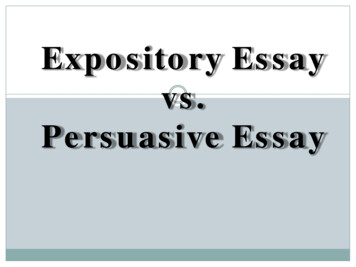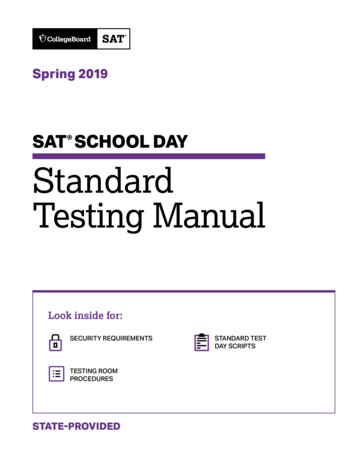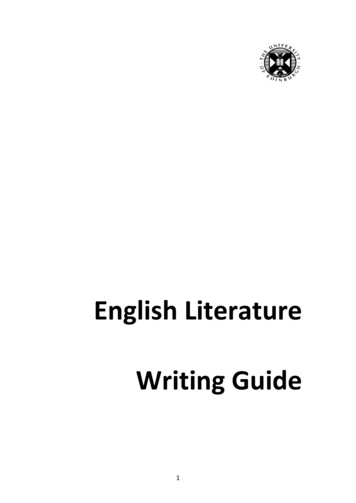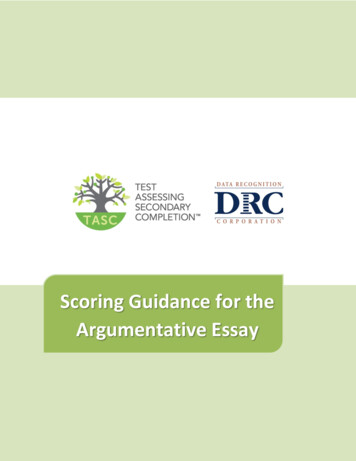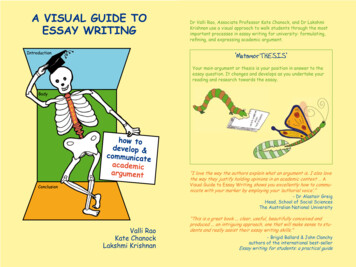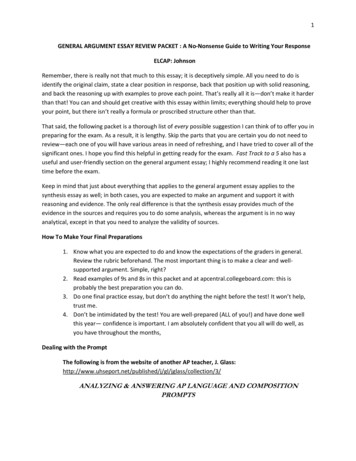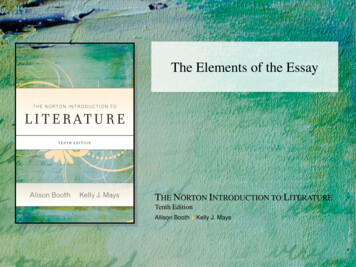
Transcription
The Elements of the EssayTHE NORTON INTRODUCTION TO LITERATURETenth EditionAllison Booth Kelly J. Mays
The Elements of the Essay An essay is a relatively short written compositionthat articulates, supports, and develops an ideaor claim. This chapter explains how tone, thesis,structure, and evidence all contribute to strong,effective essays. 2010 W.W. Norton & Company, Inc.
Tone (and Audience) The tone of an essay is shaped by its audience,situation, and purpose. Essays about literature should be geared towardan audience of educated people who have someexperience in reading literature but have readthe work at hand only once and have not yetclosely analyzed it. 2010 W.W. Norton & Company, Inc.
Thesis A thesis is an essay’s governing idea,proposition, claim, or point. A thesis must be debatable; that is, it must be aproposition that is not obviously true or factualand that must be proved with evidence from thetext. 2010 W.W. Norton & Company, Inc.
Thesis A thesis should clearly stake out a claim, but itshould not be one-sided or narrow. A goodthesis will allow complexity. Interpretive claims focus on how a text works:what it says and how it should be understood. 2010 W.W. Norton & Company, Inc.
Thesis Evaluative claims involve aesthetic or ethicaljudgments on a text. The thesis of an essay about literature shouldgenerally be an interpretive—rather than anevaluative—claim. 2010 W.W. Norton & Company, Inc.
Structure An essay’s structure should consist of abeginning (or introduction), a middle (or body),and an end (or conclusion). An essay’s introduction should articulate itsthesis, provide basic background information,and create interest in—or a motive for reading—its argument. 2010 W.W. Norton & Company, Inc.
Structure Common motives for writing and reading anessay include revealing a truth that is notimmediately obvious, identifying an interestingwrinkle in the text, or showing why a seeminglyinsignificant detail is actually important. The body of an essay should support anddevelop the thesis by presenting and analyzingevidence. 2010 W.W. Norton & Company, Inc.
Structure Each body paragraph should develop onespecific claim, stated in a topic sentence, insupport of the essay’s thesis. Body paragraphs should be ordered in a logicalsequence that is clearly signaled to the reader. 2010 W.W. Norton & Company, Inc.
Structure The conclusion should remind readers why andhow the essay was worth reading by exploringimplications, offering an evaluation, or identifyingareas of remaining ambiguity or unresolvedquestions. 2010 W.W. Norton & Company, Inc.
Evidence Each of the points or ideas in the body of anessay should be supported and developed withample, appropriate evidence. Presenting evidence involves selecting specificfacts from the literary text and activelyinterpreting them to show why they matter. 2010 W.W. Norton & Company, Inc.
Evidence Quotations should be used as evidence whentheir wording is significant. Otherwise, simplyparaphrase, describe, or summarize yourevidence. 2010 W.W. Norton & Company, Inc.
Conventions Essays about literature use the present tense torefer to actions that occur within or areperformed by the text. Underline or italicize the titles of all books orworks published independently, such as novels,plays, and long poems. 2010 W.W. Norton & Company, Inc.
Conventions Use quotation marks for works that have beenpublished as part of longer works, such as shortstories, poems, or periodical articles. The first time you refer to an author, use his orher full name; thereafter, use the last name only. When referring to characters within a literarytext, use the same conventions the text uses. 2010 W.W. Norton & Company, Inc.
The Elements of the Essay An essay is a relatively short written composition that articulates, supports, and develops an idea or claim. This chapter explains how tone, thesis, structure, and evidence all


